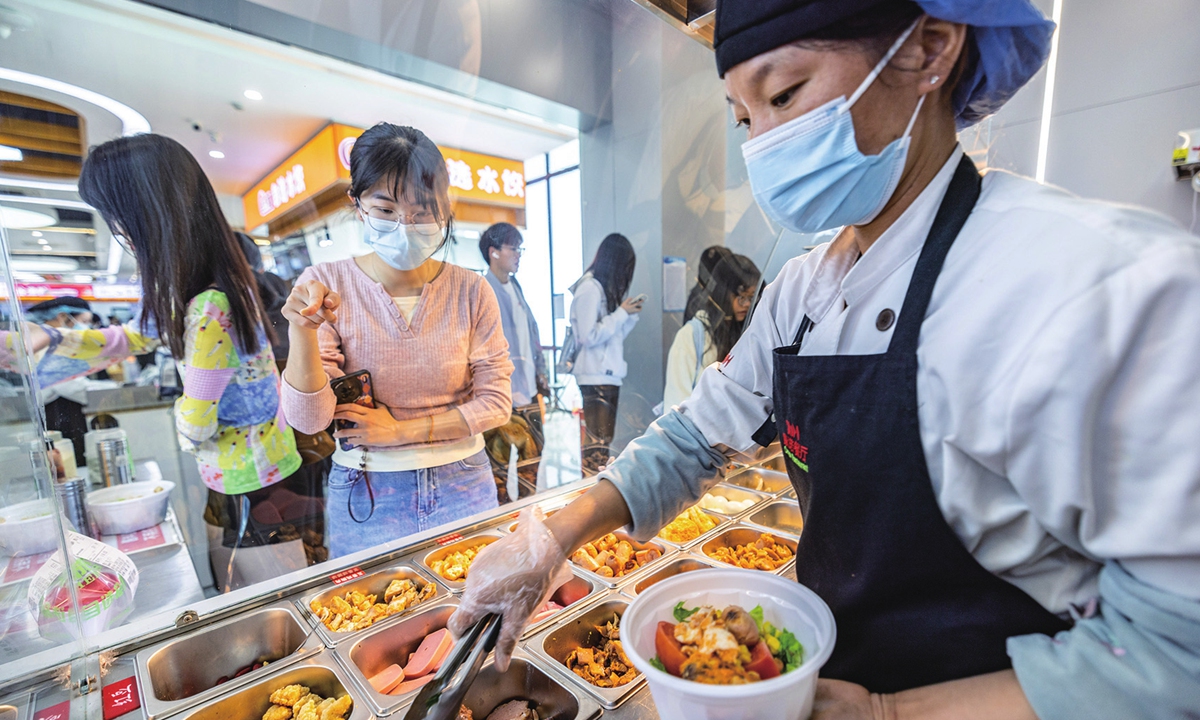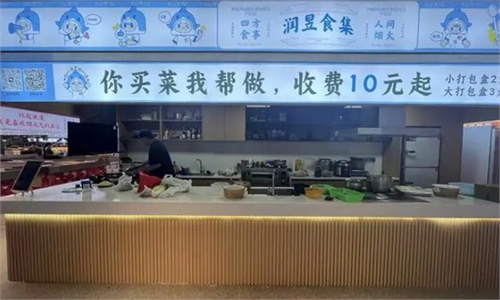ARTS / CULTURE & LEISURE
Low-fat meals win over students amid growing demand for fitness
Eating well and healthy on campus

Students line up at a light meal counter in the Huzhou University cafeteria to purchase customized low-fat meals designed for weight management on March 25, 2025. Photo: VCG
"Black-pepper chicken breast, brown rice, quinoa with bell peppers and a low-fat yogurt." At lunchtime, long queues form in front of a healthy meal station on the third floor of Beijing Language and Culture University's Qingyan Building, where many students have developed a routine for ordering their personal "standard set."
As health-conscious lifestyles continue to gain popularity among young people this year, campus dining halls across China are embracing a light meal trend.
Universities across multiple regions in China, including Beijing, Northeast China's Jilin Province, and East China's Zhejiang Province, have launched new low-fat meal options that are low in oil and salt, customizable, and quickly gaining popularity among students.
In April, Beijing Language and Culture University's Dining Services launched a series of "nutritionally balanced, low-fat and healthy" light meals. Each meal is portioned based on nutritional ratio and prices are kept below 30 yuan ($4.5) on average.
"I used to think healthy meals were bland, but now I find them quite flavorful," Li Yutong, a senior student at Beijing Language and Culture University, told the Global Times on Wednesday.
Since the healthy meal window was introduced, Li has "checked in for 21 consecutive days," noting a weight loss of three pounds.
"I've realized that eating right really does affect my energy levels and focus. I feel sharper during classes and less sluggish throughout the day," she said.
Dietary shift
Light meals are priced based on roughly 30-gram portions and allow for flexible combinations. This approach helps solo diners manage portion sizes more easily, and challenges the long-held belief that healthy eating must be expensive. This model offers a feasible solution for balanced and scientific nutrition.
The healthy meal station at Tianjin Polytechnic University now serves more than 300 students daily, reflecting that younger generations are not indifferent to health concerns, but have long lacked practical pathways to translate awareness into daily action, according to Xinhua News Agency.
Fried chicken and bubble tea dominated food delivery platforms, while health screenings showed a rising rate of fatty liver diagnoses among college students. Behind the indulgence in high-oil and high-sugar foods lay mounting metabolic strain and hidden health risks.
This year, China's National Health Commission launched a three-year weight management campaign aimed at promoting healthy lifestyles and enhancing the prevention and control of chronic diseases.
Many college students have actively engaged with the campaign by adopting balanced diets and regular exercise routines. On top of that, they are seeking scientific nutrition information and making informed food choices.
"We see more students shifting their focus from simply enjoying tasty food to prioritizing balanced nutrition and overall health," Luo Chaofan, a rehabilitation therapist with the National Health Commission, told the Global Times on Tuesday. "This is a very positive sign."
"Choosing light meals does not mean you're missing out on important nutrients, and it's not about starving yourself or extreme dieting," he said.
According to Luo, there is a fundamental difference between "eating less" and "eating right." Before the recent wave of healthy meals entered campuses, many students pursued so-called "fat-loss diets" blindly, often overlooking the body's need for a balanced intake of protein, healthy fat, and complex carbohydrates.
"Some students would eat nothing but a vegetable salad and a few egg whites in a day," he said. "They might see a quick drop in weight, but soon experience weakened immunity, dizziness, and even hair loss."
The rise of light meals is not merely a continuation of the "fat-loss" trend, but a vivid example of how health-oriented values are taking root in modern university life.
Luo noted that the growing presence of healthy meal counters in university canteens represents a quiet yet significant shift in dietary thinking. It not only gives students the option to eat healthier but also encourages a deeper sense of personal responsibility for their well-being.

A typical low-fat meal Photo: VCG
Healthy generation
When students begin asking questions like "How much protein is in this dish?" or "Is there a low-sugar version of this meal?" the university dining hall is no longer just a food place, it becomes a classroom for food education.
"Campus healthy meal counters are essentially experimental plots, pushing the entire industry to reflect on what kind of healthy diet young people need," Wang Yuxiong, a food industry professional based in Hangzhou, shared with the Global Times on Wednesday.
Wang noted that while healthy meals were originally popular among office workers in business districts, they have increasingly gained favor among university students in recent years, as reflected by user trends on food delivery platforms. "We used to worry that students lacked spending power, now we worry about not keeping up with their health awareness," Wang said.
Wang has observed that many university students include specific notes with their food orders, such as "less salt," "no added sugar," or "double protein." This kind of clear expression reflects not only a shift in consumer habits but also a growing sense of dietary autonomy.
"It's this kind of clear and rational demand that's turning light meals from a passing food fad into a long-term direction for food culture among young people," he said.
This shift is not just about what's on the plate, it reflects a new mindset. For many young people today, eating well is no longer a passive routine but a conscious dietary choice tied to responsibility, discipline, and self-care.



